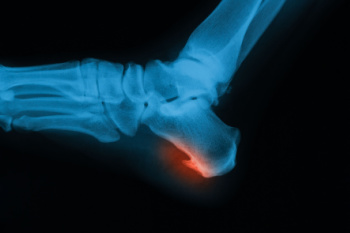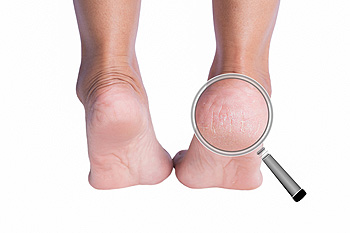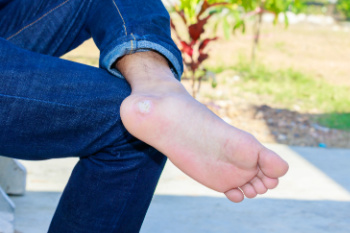Connect With Us
Blog
Items filtered by date: June 2024
Managing Hammertoe

A hammertoe is a foot deformity where toes become bent at the middle joint, typically affecting the second, third, or fourth toes. A hammertoe worsens over time due to muscle imbalance, often the result of wearing ill-fitting shoes. Shoes that are too narrow or have high heels force the toes into a bent position. This causes friction, pain, and the development of corns or calluses. Symptoms can include swelling, redness, or difficulty straightening the toe. Certain non-surgical approaches may be effective in early stages of hammertoe formation. These include wearing properly fitted shoes with a roomy toe box to alleviate pressure and allow toes to spread naturally. Exercises to stretch and strengthen toe muscles also may provide relief. Pads or cushions can be helpful, and may help to prevent further irritation. When the affected joint becomes rigid and non-flexible, surgical options like tendon lengthening or joint fusion may be necessary. If you have developed a hammertoe, it is suggested that you schedule an appointment with a podiatrist for an exam and treatment options.
Hammertoe
Hammertoes can be a painful condition to live with. For more information, contact the foot specialists from Academy Foot and Ankle Specialists. Our doctors will answer any of your foot- and ankle-related questions.
Hammertoe is a foot deformity that affects the joints of the second, third, fourth, or fifth toes of your feet. It is a painful foot condition in which these toes curl and arch up, which can often lead to pain when wearing footwear.
Symptoms
- Pain in the affected toes
- Development of corns or calluses due to friction
- Inflammation
- Redness
- Contracture of the toes
Causes
Genetics – People who are genetically predisposed to hammertoe are often more susceptible
Arthritis – Because arthritis affects the joints in your toes, further deformities stemming from arthritis can occur
Trauma – Direct trauma to the toes could potentially lead to hammertoe
Ill-fitting shoes – Undue pressure on the front of the toes from ill-fitting shoes can potentially lead to the development of hammertoe
Treatment
Orthotics – Custom made inserts can be used to help relieve pressure placed on the toes and therefore relieve some of the pain associated with it
Medications – Oral medications such as anti-inflammatories or NSAIDs could be used to treat the pain and inflammation hammertoes causes. Injections of corticosteroids are also sometimes used
Surgery – In more severe cases where the hammertoes have become more rigid, foot surgery is a potential option
If you have any questions please contact our offices located in Southlake, Keller (Fort Worth), Hurst, North Richland Hills, Flower Mound, Argyle, and Denton, TX. . We offer the newest diagnostic and treatment technologies for all your foot and ankle needs.
What Is Cuboid Syndrome?
 Cuboid syndrome is a foot condition characterized by pain on the lateral side of the foot, caused by the displacement or subluxation of the cuboid bone. This bone is one of the seven tarsal bones in the foot and plays a significant role in stability and movement. Cuboid syndrome typically occurs due to repetitive strain, overuse, or an acute injury such as an ankle sprain. Though not as common as other foot injuries, cuboid syndrome is often seen in athletes, particularly dancers and runners, due to the high impact and stress placed on their feet. The pain is usually sharp and localized around the cuboid bone, exacerbated by weight-bearing activities and certain movements like pushing off the ground. Diagnosis involves a physical examination, focusing on the foot's range of motion and palpation to identify tenderness over the cuboid bone. Imaging tests are rarely necessary but may be used to rule out other conditions. Risk factors include wearing improper footwear, overtraining, having flat feet, or a pronated foot type. Treatment typically involves rest and manual manipulation of the cuboid bone, along with orthotic devices for support. If you have pain in this area of your foot, it is suggested that you schedule an appointment with a podiatrist for an accurate diagnosis and effective treatment plan.
Cuboid syndrome is a foot condition characterized by pain on the lateral side of the foot, caused by the displacement or subluxation of the cuboid bone. This bone is one of the seven tarsal bones in the foot and plays a significant role in stability and movement. Cuboid syndrome typically occurs due to repetitive strain, overuse, or an acute injury such as an ankle sprain. Though not as common as other foot injuries, cuboid syndrome is often seen in athletes, particularly dancers and runners, due to the high impact and stress placed on their feet. The pain is usually sharp and localized around the cuboid bone, exacerbated by weight-bearing activities and certain movements like pushing off the ground. Diagnosis involves a physical examination, focusing on the foot's range of motion and palpation to identify tenderness over the cuboid bone. Imaging tests are rarely necessary but may be used to rule out other conditions. Risk factors include wearing improper footwear, overtraining, having flat feet, or a pronated foot type. Treatment typically involves rest and manual manipulation of the cuboid bone, along with orthotic devices for support. If you have pain in this area of your foot, it is suggested that you schedule an appointment with a podiatrist for an accurate diagnosis and effective treatment plan.
Cuboid syndrome, also known as cuboid subluxation, occurs when the joints and ligaments near the cuboid bone in the foot become torn. If you have cuboid syndrome, consult with the foot specialists from Academy Foot and Ankle Specialists. Our doctors will assess your condition and provide you with quality foot and ankle treatment.
Cuboid syndrome is a common cause of lateral foot pain, which is pain on the outside of the foot. The condition may happen suddenly due to an ankle sprain, or it may develop slowly overtime from repetitive tension through the bone and surrounding structures.
Causes
The most common causes of cuboid syndrome include:
- Injury – The most common cause of this ailment is an ankle sprain.
- Repetitive Strain – Tension placed through the peroneus longus muscle from repetitive activities such as jumping and running may cause excessive traction on the bone causing it to sublux.
- Altered Foot Biomechanics – Most people suffering from cuboid subluxation have flat feet.
Symptoms
A common symptom of cuboid syndrome is pain along the outside of the foot which can be felt in the ankle and toes. This pain may create walking difficulties and may cause those with the condition to walk with a limp.
Diagnosis
Diagnosis of cuboid syndrome is often difficult, and it is often misdiagnosed. X-rays, MRIs and CT scans often fail to properly show the cuboid subluxation. Although there isn’t a specific test used to diagnose cuboid syndrome, your podiatrist will usually check if pain is felt while pressing firmly on the cuboid bone of your foot.
Treatment
Just as the range of causes varies widely, so do treatments. Some more common treatments are ice therapy, rest, exercise, taping, and orthotics.
If you have any questions, please feel free to contact our offices located in Southlake, Keller (Fort Worth), Hurst, North Richland Hills, Flower Mound, Argyle, and Denton, TX. . We offer the newest diagnostic and treatment technologies for all your foot care needs.
Causes Of Cracked Heels
 Cracked heels can be caused by many factors. The skin on heels are naturally dry and may crack when exposed to long periods of pressure, such as standing. Additionally, wearing open-backed shoes, like sandals, may progress the condition by allowing the skin to expand and split. Other causes of cracked heels include the lack of moisture from harsh weather and underlying health conditions. Certain medical conditions, including diabetes, eczema, psoriasis, and thyroid disorders, also may be factors in cracked skin on the heels. The aging process can aid in development of cracked heels, due to the skin losing its flexibility over time. Proper foot care, such as moisturizing and supportive footwear, may help prevent this condition. Podiatrists can provide professional care and guidance to manage and treat cracked heels. If the cracked skin on your heels forms fissures or begins to bleed, it is suggested that you consult a podiatrist for treatment to avoid infection.
Cracked heels can be caused by many factors. The skin on heels are naturally dry and may crack when exposed to long periods of pressure, such as standing. Additionally, wearing open-backed shoes, like sandals, may progress the condition by allowing the skin to expand and split. Other causes of cracked heels include the lack of moisture from harsh weather and underlying health conditions. Certain medical conditions, including diabetes, eczema, psoriasis, and thyroid disorders, also may be factors in cracked skin on the heels. The aging process can aid in development of cracked heels, due to the skin losing its flexibility over time. Proper foot care, such as moisturizing and supportive footwear, may help prevent this condition. Podiatrists can provide professional care and guidance to manage and treat cracked heels. If the cracked skin on your heels forms fissures or begins to bleed, it is suggested that you consult a podiatrist for treatment to avoid infection.
Many people suffer from bouts of heel pain. For more information, contact the foot specialists of Academy Foot and Ankle Specialists. Our doctors can provide the care you need to keep you pain-free and on your feet.
Causes of Heel Pain
Heel pain is often associated with plantar fasciitis. The plantar fascia is a band of tissues that extends along the bottom of the foot. A rip or tear in this ligament can cause inflammation of the tissue.
Achilles tendonitis is another cause of heel pain. Inflammation of the Achilles tendon will cause pain from fractures and muscle tearing. Lack of flexibility is also another symptom.
Heel spurs are another cause of pain. When the tissues of the plantar fascia undergo a great deal of stress, it can lead to ligament separation from the heel bone, causing heel spurs.
Why Might Heel Pain Occur?
- Wearing ill-fitting shoes
- Wearing non-supportive shoes
- Weight change
- Excessive running
Treatments
Heel pain should be treated as soon as possible for immediate results. Keeping your feet in a stress-free environment will help. If you suffer from Achilles tendonitis or plantar fasciitis, applying ice will reduce the swelling. Stretching before an exercise like running will help the muscles. Using all these tips will help make heel pain a condition of the past.
If you have any questions please contact our offices located in Southlake, Keller (Fort Worth), Hurst, North Richland Hills, Flower Mound, Argyle, and Denton, TX. . We offer the newest diagnostic and treatment technologies for all your foot and ankle needs.
Treating Stubborn Plantar Warts
 Plantar warts are skin growths, typically found on the soles of the feet, that are caused by the human papillomavirus, or HPV. They most often develop on pressure points, such as the heels or balls of your feet. They may cause discomfort or pain when standing or walking. Plantar warts are characterized by a rough, grainy appearance and may have small black dots at the center, which are actually clotted blood vessels. While some warts can eventually clear up on their own, stubborn plantar warts need medical intervention. A podiatrist, or foot doctor, can treat resistant warts using stronger medications like salicylic acid, cryotherapy, laser treatment, or even minor surgery to remove the wart. These methods not only help eliminate the warts, but also help prevent the spread of the virus to other parts of the foot or to other people. If you have plantar warts, it is suggested you consult a podiatrist for an exam and personalized treatment options.
Plantar warts are skin growths, typically found on the soles of the feet, that are caused by the human papillomavirus, or HPV. They most often develop on pressure points, such as the heels or balls of your feet. They may cause discomfort or pain when standing or walking. Plantar warts are characterized by a rough, grainy appearance and may have small black dots at the center, which are actually clotted blood vessels. While some warts can eventually clear up on their own, stubborn plantar warts need medical intervention. A podiatrist, or foot doctor, can treat resistant warts using stronger medications like salicylic acid, cryotherapy, laser treatment, or even minor surgery to remove the wart. These methods not only help eliminate the warts, but also help prevent the spread of the virus to other parts of the foot or to other people. If you have plantar warts, it is suggested you consult a podiatrist for an exam and personalized treatment options.
Plantar warts can be very uncomfortable. If you need your feet checked, contact the foot specialists from Academy Foot and Ankle Specialists. Our doctors will assist you with all of your foot and ankle needs.
About Plantar Warts
Plantar warts are the result of HPV, or human papillomavirus, getting into open wounds on the feet. They are mostly found on the heels or balls of the feet.
While plantar warts are generally harmless, those experiencing excessive pain or those suffering from diabetes or a compromised immune system require immediate medical care. Plantar warts are easily diagnosed, usually through scraping off a bit of rough skin or by getting a biopsy.
Symptoms
- Lesions on the bottom of your feet, usually rough and grainy
- Hard or thick callused spots
- Wart seeds, which are small clotted blood vessels that look like little black spots
- Pain, discomfort, or tenderness of your feet when walking or standing
Treatment
- Freezing
- Electric tool removal
- Laser Treatment
- Topical Creams (prescription only)
- Over-the-counter medications
To help prevent developing plantar warts, avoid walking barefoot over abrasive surfaces that can cause cuts or wounds for HPV to get into. Avoiding direct contact with other warts, as well as not picking or rubbing existing warts, can help prevent the further spread of plantar warts. However, if you think you have developed plantar warts, speak to your podiatrist. He or she can diagnose the warts on your feet and recommend the appropriate treatment options.
If you have any questions please feel free to contact our offices located in Southlake, Keller (Fort Worth), Hurst, North Richland Hills, Flower Mound, Argyle, and Denton, TX. . We offer the newest diagnostic and treatment technologies for all your foot and ankle needs.
